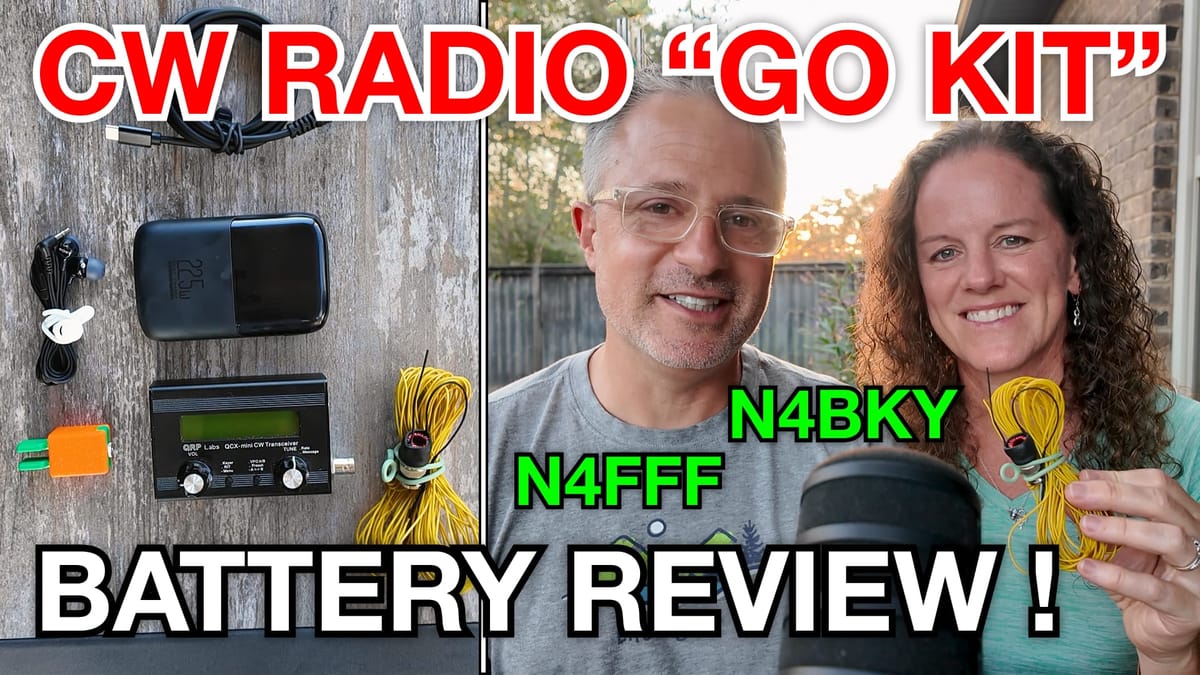Our Portable Radio Go Kit and USB-C PD Battery

In this post, we’ll break down our review of the new battery we’re using in our portable radio go kit, specifically designed for POTA (Parks on the Air) activations but would come in handy for emergencies. We’ll discuss everything that’s included in the kit, our thoughts on the gear, and how the battery performed after using it all weekend. Check out the video below were we cover everything shared here.
Why a "Go Kit"?
We primarily use our "go kit" for POTA activations, but it’s versatile enough to be used for emergency preparedness. We put "go kit" in quotes because, for us, it is primarily for fun with POTA but also serves as our kit for potential emergencies. With recent devastating hurricanes in the Southeast, we’ve been reminded of the critical role amateur radio operators play during natural disasters. It’s comforting to know that with our "go kit", we could assist in communication efforts in an emergency.
What’s in the Go Kit?
Let’s dive into the essential gear that makes up our go kit.
Radio: QCX Mini by QRP Labs
The heart of the go kit is the QCX Mini, a compact radio by QRP Labs. This little radio, about the size of a deck of cards, weighs just over 200 grams and is perfect for CW (Morse code) enthusiasts. We picked the 20m band version, as it’s our favorite for portable activations due to its versatility and ease of deployment.
We love this radio because it demonstrates why we love CW – we can take a radio the size of a deck of cards to play radio wherever go on our nature adventures! To put it in perspective, some say 5 watts of CW is roughly equivalent to 50 watts on voice modes – we'd believe it based on our experiences! Plus, at only $60 if you build it yourself (or $110 pre-built), it’s an affordable, powerful option for portable radio use.
Antenna: End-Fed Halfwave by K6ARK
The second most important part of the kit is our End-Fed Halfwave (EFHW) antenna from K6ARK. The transformer is built into the connector, which makes the entire kit lighter and easy to deploy because there is no need for a coax cable. The EFHW is perfect for throwing up into a tree, and because we built it for the 20m band, it provides the right balance of practicality for POTA activations.
Mini CW Paddle by K6ARK
For sending CW, we use a 3D-printed mini paddle by K6ARK. This little device costs about $3 to put together and weighs only 12 grams, making it ideal for lightweight, portable setups.
Headphones
You’ll need a reliable way to listen, so we included a pair of affordable, lightweight headphones from Amazon (weighing just 11 grams). Simple and effective!
USB-C PD Battery and 12V Trigger Cable
The newest addition to our kit is a USB-C Power Delivery (PD) battery bank. We tested it all weekend and loved how well it worked with our radio. One thing to note is that not all PD batteries output the 12 volts required for QRP radios, so you’ll need to be careful when choosing both the battery and the cable. You also need to make sure you are using a 12V cable so that it will tell the power bank to output 12V. We used a multi-meter to verifiy before ever plugging into our radio!
We use a 12V trigger cable that tells the battery to output the correct voltage. Without this, you risk damaging your radio. In our case, the battery outputs a steady 12 volts, perfect for our QCX Mini.
The battery we purchased cost $21 on Amazon, and the cable was about $9. In comparison to our LiPo battery, which is heavier and requires more caution when charging, this setup is far more convenient.
Final Thoughts
For a grand total of around $120 (excluding shipping), we’ve built a lightweight, effective POTA go kit. The entire setup weighs 507 grams (1.2 lbs), making it easy to throw into a backpack and take on the go.
This kit has proven to be a great tool not only for POTA activations but also for emergency preparedness. We’re confident that in any situation, we could make the contacts we need. And in the meantime, we’ll be having fun playing radio!
If you’re looking to get started with portable activations, this kit is an affordable and practical way to dive in.
Summary of Go Kit Components
- Radio: QCX Mini by QRP Labs - Cost: $60 (kit) / $110 (pre-built), Weight: 200 grams
- Antenna: End-Fed Halfwave by K6ARK - Cost: $20, Weight: 45 grams
- Mini CW Paddle by K6ARK - Cost: $3, Weight: 12 grams
- Headphones - Cost: $7, Weight: 11 grams
- USB-C PD Battery - Cost: $21, Weight: 195 grams
- 12V Trigger Cable - Cost: $9, Weight: 42 grams
If you want to see it in action, check out our YouTube channel were we regularly post POTA and SOTA activations. Don’t forget to subscribe to our channel for more activations and gear reviews!
🔗 Some of the links above are affiliate links with no additional cost to you. Purchasing through these links helps support our channel. Thank you.




